A six day International Tour to NE Spain, up into the Pyrenees and out onto the Steppe, organised together our friends from Oriole Birding. This is a new destination for us, and we plan to run the tour again at the same time next year, so if you like what you see, you would be welcome to join us for our next visit, in 2021!
WEDNESDAY 26TH FEBRUARY
A long day awaited us today as we had a 5am meet in Gatwick Airport for the early flight to Barcelona, which arrived ahead of schedule around 0945 local time. We enjoyed an incredibly swift transit of the airport (Brexit? What Brexit!) and we soon united with our minibus for the week and onto the motorway network.
Our first planned stop was actually only five minutes away, in an area of cultivation and scattered poplars at the edge of the city. Here we had a good reliable spot for Iberian Green Woodpecker, a species which has been propelled up people’s wants list by its full specific status. It was quite windy at the location, but we were soon enjoying our first sightings of Black Redstart, Serin, Ring-necked Parakeet (which are breeding all around the city), Cattle Egret, and other common birds. Soon an Iberian Green Woodpecker flew across, and perched beautifully in the open for us – the first of 5-6 views of 3 different birds we enjoyed here. We had some superb scope views, and got to hear them calling too.

Other birds in the trees and scrub included an obliging Short-toed Treecreeper, male Sardinian Warbler and a surprise Zitting Cisticola which we flushed up from the vegetation as we walked along. Overhead, a lovely mixed flock of Crag Martins with a few House Martins thrown in, migrated north over us. The light was excellent and we could easily see the white windows in the Crag Martin tail feathers. A Little Owl also obliged here, flying up and perching angrily in a dead Poplar tree and glaring back at us over its shoulder. We had made a good start, but now it was time to crack on – to the mountains!
We had a drive north of around two hours to reach the high Pyrenees, and this was punctuated by a break for coffee and lunch near Berga. Pressing on, we began to wind our way towards Coll de Pal where we would be trying for Snowfinch in particular, a notoriously difficult species at this time of year when the snow is receding. Before we left the treeline, a large raptor circled into view ahead of us – it was a stunning adult Lammergeier! Thankfully the road was quiet and we could easily stop, and thankfully the bird did us a favour and circled back right over us.

While watching the Lammergeier, we heard the ‘toy trumpet’ toot of a Citril Finch – wow! We didn’t see the bird, however, and suspect it was flying off when we heard it. There was one more call from it among the pines, where it was clearly associating with a roving flock of Chaffinch, but we werenit lucky with a sighting. A Crested Tit showed really well though, and was a nice addition. In the meantime, the Lammergeier had reappeared and actually landed on the hillside where we could see it mantling something on the ground – great views of this iconic Pyrenean speciality so early in the trip!
Reaching the high ground, the view was stunning – wall to wall blue sky and sunshine, though with a cold wind. Sadly though, this coupled with the general lack of snow this year meant that the chances of Snowfinch were slim. They would be up in the highest peaks already, especially on such a nice day. We explored the area as best we could, but noted only Mistle Thrush and Griffon Vulture for our troubles – it was a beautiful place though! We did do marginally better on mammals too, with a Fox hunting way up on the hillside, and fantastic views of several close groups of Chamois.

We wound our way back down to Baga, and then continued north up the main road to our overnight stop in the village of Olopte. Farran our host met us and showed us to our rooms, and we had a swift turnaround before heading back out. A Tengmalm’s Owl was holding territory about 20 minutes drive away, and we knew it had been heard on two of the previous three evenings. We simply had to give it a go, even though we knew the chance was small. The wind dropped and under a starlit sky we listened at several spots along the road but only heard a distant Tawny Owl. So it was back to the restaurant for a pleasant dinner, and then to bed – it had been a long one!
THURSDAY 27TH FEBRUARY
An early morning bonus for two of the group today was a Beech Marten on the feeding table in the semi-darkness – a speciality of the hotel but we had failed to see it last night under the floodlights. Our day kicked off proper after breakfast as we packed up and left Olopte under blue skies and the temperature gauge flashing 0C on the van.
We wound our way back up into the hillside where we had searched last night for the Tengmalm’s, but this morning we had a different target here – Citril Finch. This species is notoriously difficult at this time of year, as it is in transition between wintering and breeding locations and so highly mobile and weather dependent in their habits. Add to that their elusive nature and we knew we would have a task on our hands to get everyone a view of one! Nevertheless it was a stunning morning, and as we parked by a clearing just below a small ski station it was clear that there were lots of small birds out and about in the sunshine.
Chaffinches were moving through the pines in large numbers, and a few Greenfinch and Goldfinch were with them. Crested Tits were calling all around and showed really well, and Common Crossbills were also very numerous and perching up beautifully in the treetops for us. We remarked at how different their calls sounded to our own race, being higher pitched and less ‘chippy’! A real bonus here were a couple of Rock Buntings – we had a fine male perched up in a dead tree and a couple more calling around the clearing. Their high-pitched contact note is very hard to pinpoint, always seeming closer than it is in reality. There were no Citril Finches here though, so we decided to try a bit higher up.
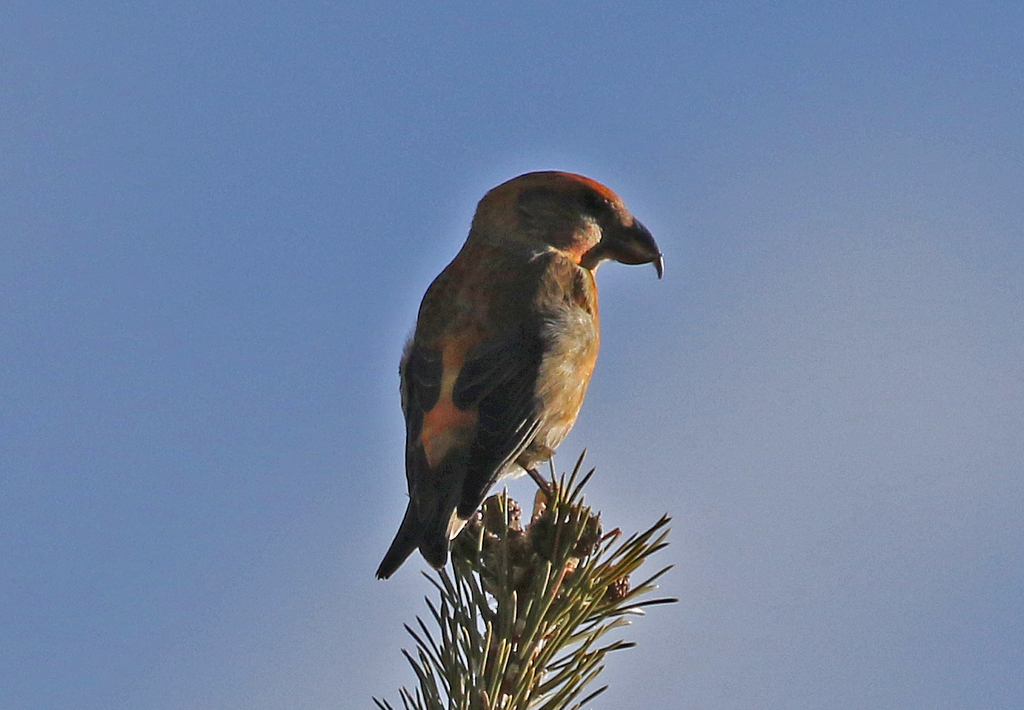
The ski stations were busy and there was lots of traffic about, but we managed to find a quiet corner of the next car park area, overlooking an open snowy area flanked by pines. A surprise here was an unfamiliar wheezy call overhead which turned out to be a Rock Sparrow, and we were fortunate that it pitched down and landed in a pine for scope views.
There were lots more finches moving in the trees here, and we remained on high alert for our main quarry. Sure enough, the distinctive ‘toot-toot’ flight call was heard and a Citril Finch flew in low from behind us. Luckily, it landed in the top of a conifer really close to us and gave two or three of the group a good view before it flew again and disappeared over the treetops – a typical view! We persevered, and saw another 2-3 birds flying distantly with the Chaffinches but couldn’t pin them down. We drove back down a little, enjoying more close perched views of Crossbills, Crested Tits and a lovely Short-toed Treecreeper.
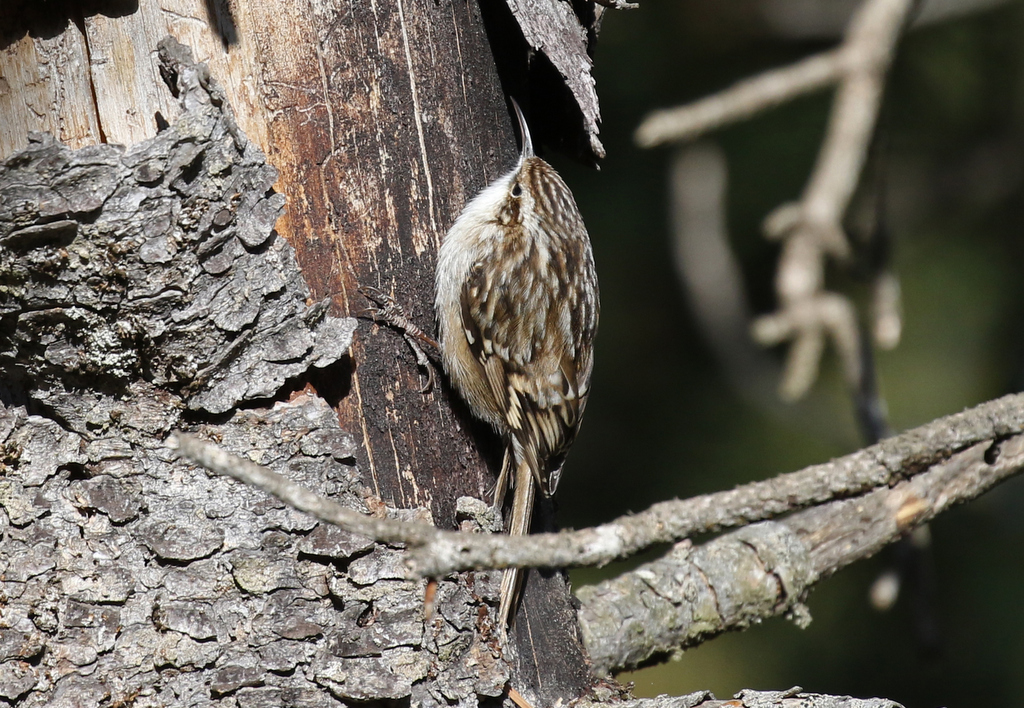
Our final stop here was again higher up the hillside at another large clearing, and here we finally nailed our main target properly. Citril Finch was calling frequently and we had several frustratingly brief glimpses and flight views. We had almost given up as time was running out, when one began singing in the trees just by our parking spot – it flew into view and perched in the open in a dead tree, giving everyone the scope view they were after. Brilliant!
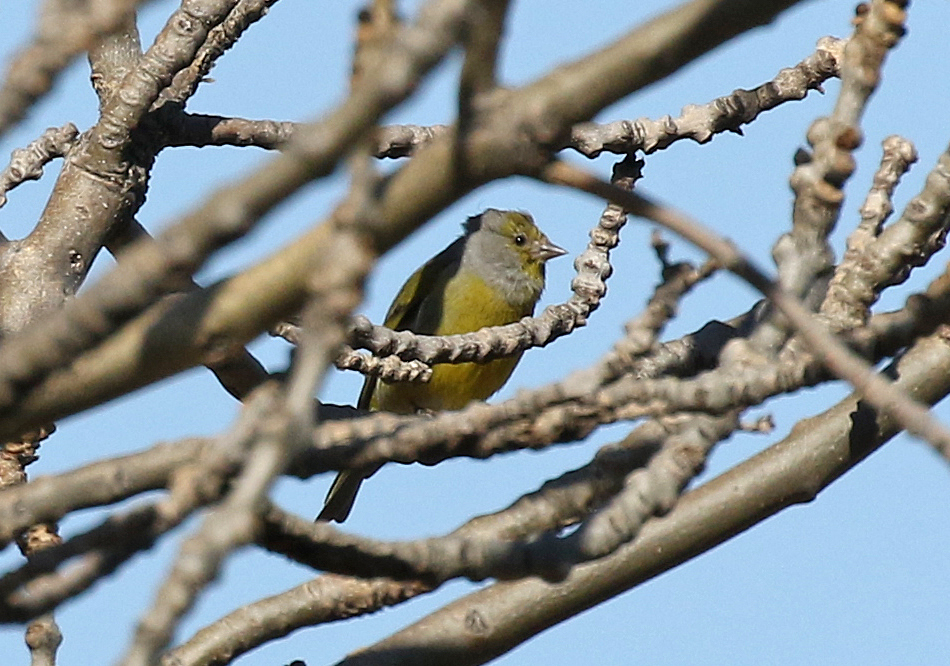
We now had a long drive of around two hours, to descend back down to Manresa and then along the main road towards Lleida. We paused for lunch and coffee at the same spot as yesterday, breaking up the journey to our first afternoon birding spot at Estany D’Ivars. This reed-fringed lagoon added a number of new species to our list, as large numbers of gulls were loafing, and wildfowl on the lake included small numbers of Teal, Shoveler and Red Crested Pochard.
Chiffchaffs were flitting among the reeds and our main target here was easy to find – a lovely pair of Penduline Tits feeding close to the track. Common Snipe, Little and Great Crested Grebe and Grey Heron were seen, while several Crag Martins hawking over the far side of the pool harboured Swallow and House Martin too. Other species we saw nearby included many White Storks, a brace of Hoopoe and a couple of small flocks of Common Cranes.

Ten minutes up the road, we wanted to check a spot where there is regularly a wintering flock of Little Bustards. We checked the alfalfa fields carefully, noting a small flock of Golden Plovers but no sign of our quarry. We made a u-turn and just as we were making our way back along the road, a party of birds exploded from cover and flew high up over the highway – a dozen Little Bustards!
They flew around for a couple of minutes, before dropping in another roadside field where we could see a row of alert heads and necks poking out of a cereal crop! We parked up and put a scope on them, before they flew again. This time though, they decided to come our way, landing in the bare field right next to our parking spot. Amazingly though, they blended straight in and disappeared despite the field not appearing to have anywhere much for them to hide! We did manage some decent scope views though, and we had been very lucky indeed to connect with them.
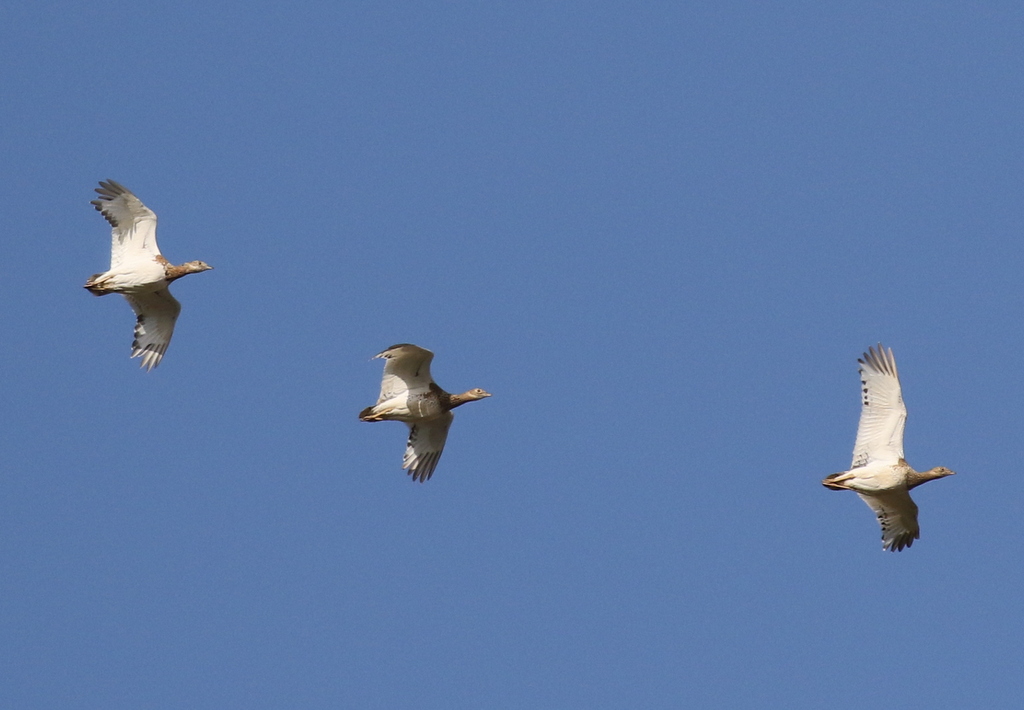
Our final stop of the day was a small gorge and dam at the head of a reservoir, on our route west towards our base for the night near Huesca. We hoped to see Bonelli’s Eagle here, but we didn’t have too much time to look. It was a lovely spot, and quite sheltered too from the strengthening winds. A Griffon Vulture was perched on a prospective nesting ledge, and Crag Martins were wheeling around calling. Near the dam, we looked up to see a large raptor gliding over – an adult Bonelli’s Eagle! A fairly brief view, but a good one and again a bit fortunate given our fairly whistle-stop visit.
We were about to get even luckier though, as a flicking motion on the rock face across the river heralded the presence of one of our main trip targets – the much sought-after Wallcreeper! It was a superb spot by Reg, to pick it out with bins so far away, and we were all able to enjoy it through the scopes for several minutes as it flitted around in the open.

We even squeezed in a Dipper and Common Sandpiper on the river – a superb afternoon! Now we had a final one hour drive west to our accommodation in the village of Arbanies, nestled beneath the foothills of the Sierra de Guarra.
FRIDAY 28TH FEBRUARY
Another beautiful fine day awaited us as we had a more relaxed time after two long days, and explored the key areas fairly close to our base. Vadiello would be our first stop, and the plan here was to try and get some better views of Wallcreeper. This did not materialise, and for the first time ever we drew a blank for the species here.
We spent a couple of hours checking the quarries, tunnels, cliff faces and dam itself, to no avail. Of course, we saw a number of other nice birds in the process though, particularly Griffon Vultures which were abundant, and giving some excellent views throughout the morning. We had point blank views of a singing Firecrest, brief views of a couple of Rock Sparrows, several Black Redstarts, two more Rock Buntings, Peregrine and large numbers of Crag Martins too.
Late morning we headed back towards the main road and after stops for fuel and coffee, and adding our first migrating flock of Black Kites, we headed for Castillo de Montearagon just north-east of Huesca. This location is a great place to see Black Wheatear, and was our main reason for visiting. Griffon Vultures were again pouring overhead, probably on migration, and a scattering of Black Kites were with them. Best of all though was a fantastic migration of Common Cranes, and we saw several large flocks totalling up to one thousand birds – it was a really brilliant sight and sound and a highlight of the day.
Up at the castle, we then located a nice male Black Wheatear and had some lovely prolonged scope views of it sallying around on the ledges below us. A male Blue Rock Thrush was also present, and several Black Redstarts were around too. We decided this was a very pleasant spot to sit and have lunch, in the company of several singing Thekla Larks – all in all, not a bad morning.

For the afternoon, we headed to a new site for us, about forty minutes to the east. The medieval town of Alquezar is a stunning place, with immaculate cobbled streets and an impressive Castillo, overlooking a rocky gorge and with spectacular views back to the south. We had been told of wintering Alpine Accentors here, though unfortunately we couldn’t find any today – most likely they had already left for the high tops given the incredibly mild weather.
It was really birdy around the village though, and in particular the ivy-clad rocks around the Castillo were absolutely thronged with Song Thrushes and Blackcaps. The latter were all sub-singing creating a constant backdrop of sound – there must have been hundreds of them around the village as a whole. Blue Rock Thrush was also easily seen, and Griffon Vultures were just spectacular – the eye level views of them passing by were quite something.
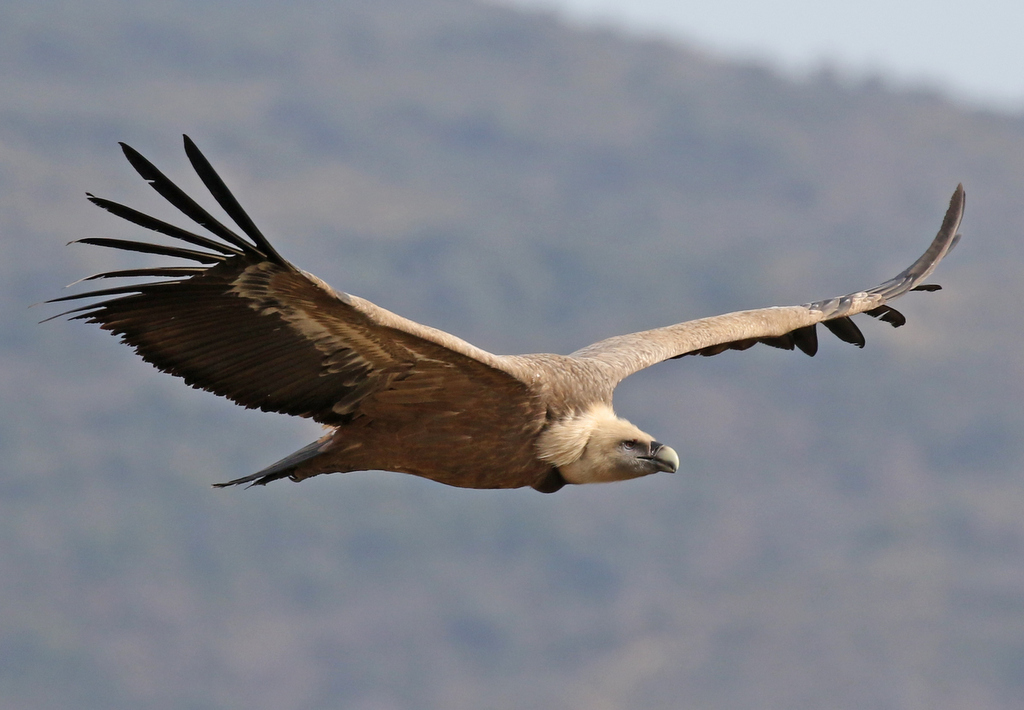
Two Lammergeiers were seen, including an adult low overhead, and a male Hawfinch was hopping around in the open below the viewpoint. We also saw a Wallcreeper here – initially in flight coming across the gorge, we then had several glimpses of it through the scope over the next hour or so, but it kept disappearing frustratingly into a cleft which we couldn’t see into. Nevertheless, everyone saw it quite well despite the distance, and it was good to see another one! That rounded off our day, as we aimed to get back to the accommodation a bit earlier after the exertions of the last two days.
SATURDAY 29TH FEBRUARY
A challenging day today as a combination of dreary weather and some challenging birds meant we were not in for an easy ride! We journeyed north towards the High Pyrenees above Jaca, but first we turned south from the town towards the mountain of Oroel, and wound our way uphill towards the turning up to the parador. A short roadside stop produced good views of our first Cirl Buntings of the trip, keeping company with a single Rock Bunting.
Continuing up higher, we reached the forest on the northern slopes of Oroel where we hoped to find Black Woodpecker among the pines. It was quite busy here with walkers, with it being a Saturday, and also completely snow-free. We wandered through the pines to the east of the parking area, and were soon hearing Crested Tit, Firecrest and Short-toed Treecreeper among the trees.
Our tactic was to walk quietly along and listen for the calls of Black Woodpecker, and we didn’t have to wait too long before we heard a fairly distant flight call of one further down the track ahead. We headed there and listened for more calls, hearing the full call then from a bit further up the slope. This game of cat and mouse continued for a while, until we gave up and started heading back towards the parking area.
However, we were stopped in our tracks by another Black Woodpecker calling really close to the path, and the bird then flew out and low over the treetops below us giving a really nice view. We then listened to the bird drumming and calling from an area of dense trees up a gulley, and managed a few more glimpses of it in flight.
With this target in the bag, we descended again to Jaca, and then took the road north to the ski stations on the French border at Astun and Candanchu. The snow levels were incredibly low, the least amount we have ever seen here, but because the upper slopes were open for skiing, the area was extremely busy. It was also now raining – not a great combination! We sheltered in the car for lunch and then as the rain eased, we had a wander round.
About eleven Alpine Choughs were seen in total, including some close views of a pair perched on a low roof. Wanting to escape the crowds, we jumped back in the van and drove down to Candanchu, which was much quieter. There were around 50 Alpine Choughs here too, so we were very happy with the views we had of this species. Unfortunately though, the lack of snow and mild weather meant there were no Alpine Accentors to be found at either site today.
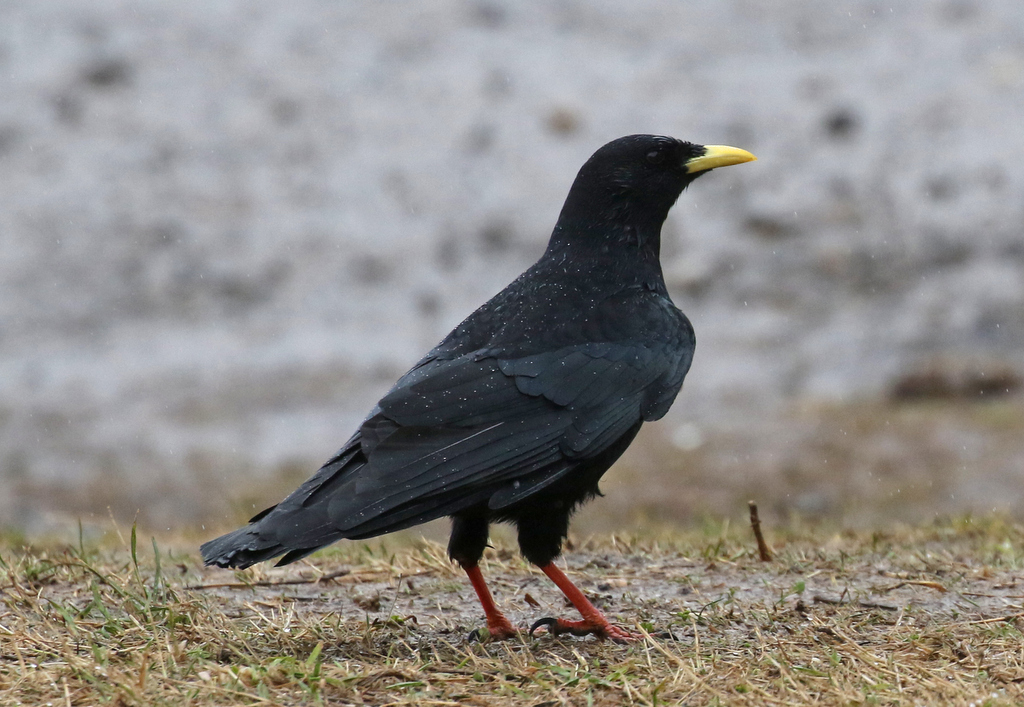
From here we had another ninety minute drive, south to Los Mallos de Riglos to end the afternoon. Here we walked up through the narrow streets to scan the impressive sandstone cliffs and check the slopes below for another slim chance of Accentors. We didn’t find any, and had to make do with a fine male Blue Rock Thrush, male Sardinian Warbler and a flock of 35 Red-billed Choughs.
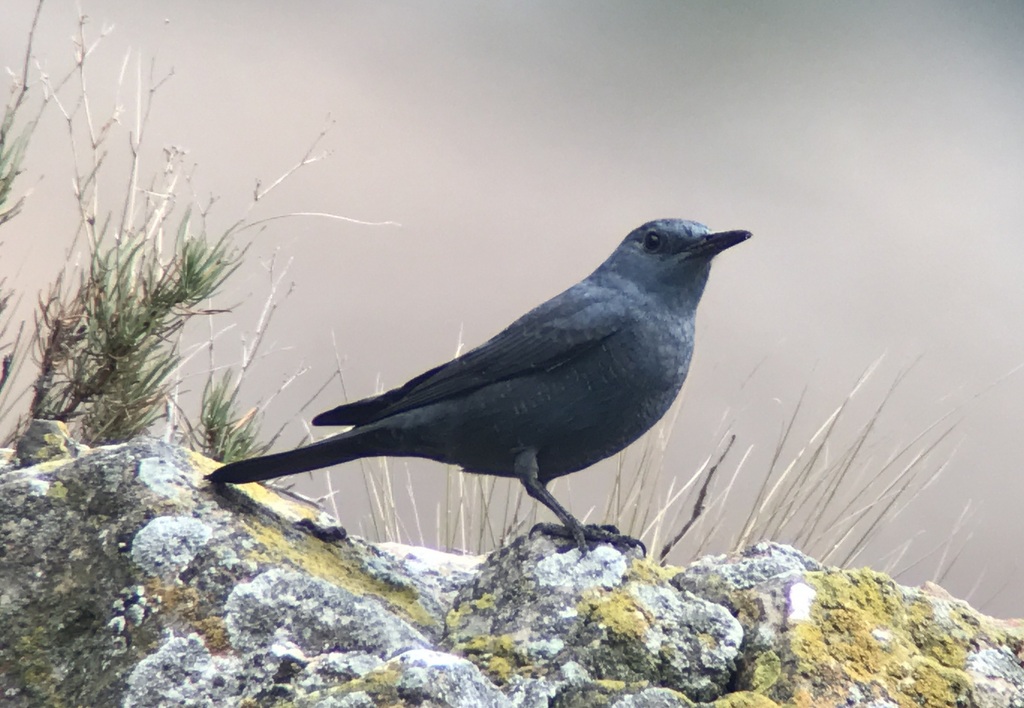
There were lots of Griffon Vultures, a few Black Kites and a small flight of Cranes in the distance too. Not a total failure, and despite the drizzle, another really nice location to visit. From here we had about fifty minutes drive back to base, which was mainly through now fairly heavy rain.
SUNDAY 1ST MARCH
A superb days birding today as we left Casa Oliban and made the ninety minute drive south via Zaragoza to the SEO reserve at El Planeron. The weather is key to success here with the ‘ghost bird’ for which the site is famous, and we were really lucky with light winds at the start of the day and plenty of sunshine meaning the air was bursting with lark song as we arrived in the steppes.
Calandra and Lesser Short-toed Larks would be everywhere for the rest of the morning, and we had superb views of both species. But it was Dupont’s Lark that we were really after here, and we didn’t have to wait long before we heard our first one signing – such a wonderful, musical tune but ventriloquial and often delivered from the ground, in cover and seldom in the open.
Our first vigil was tense and despite hearing at least three different birds in one area, we hadn’t managed a sighting. Soon though, we picked up a Dupont’s Lark scurrying furtively among the low shrubs, and then it ran across the track in front of us. We noticed that it seemed to be carrying food, and we soon worked out what was going on – the bird had a nest nearby. We stood quietly and waited, and it repeated the same route two or three times more, and we were all able to get some superb scope views as it stopped frequently to grub around in the base of the small bushes.
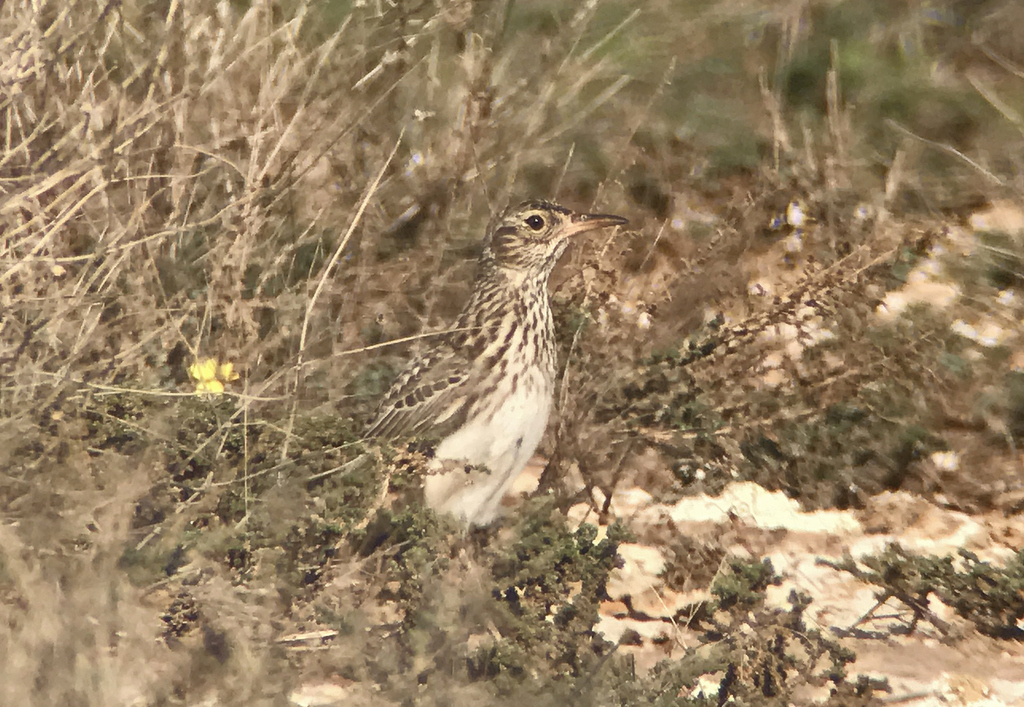
We also had another bird in full song flight high above the steppe, before plummeting down vertically back into cover. We had done really well! El Planeron is not just about Dupont’s though, it is also an excellent birding site in general – we saw Iberian Grey Shrikes, a gorgeous adult male Hen Harrier, a Golden Eagle adult right overhead and a couple of passage Cranes. Not a bad morning!
After a coffee stop in Quinto, we continued on into Los Monegros steppes to have a search for the Great Bustard flock that is in the area. Lunch was at Laguna la Playa, a big salt lagoon, where we added seventeen Little Stints, five Dunlin and eight Kentish Plovers. Forty Shelduck were also present here and we noted a sprinkling of Red-billed Choughs in the steppe around.
Back onto the bustard trail after lunch and we were really, really lucky today – a flock of ten Great Bustards found us as they flew in and landed in the field alongside our van! Finding a good spot a few hundred metres back, we parked and carefully got out to scope them – brilliant views of this batchelor group of young males.
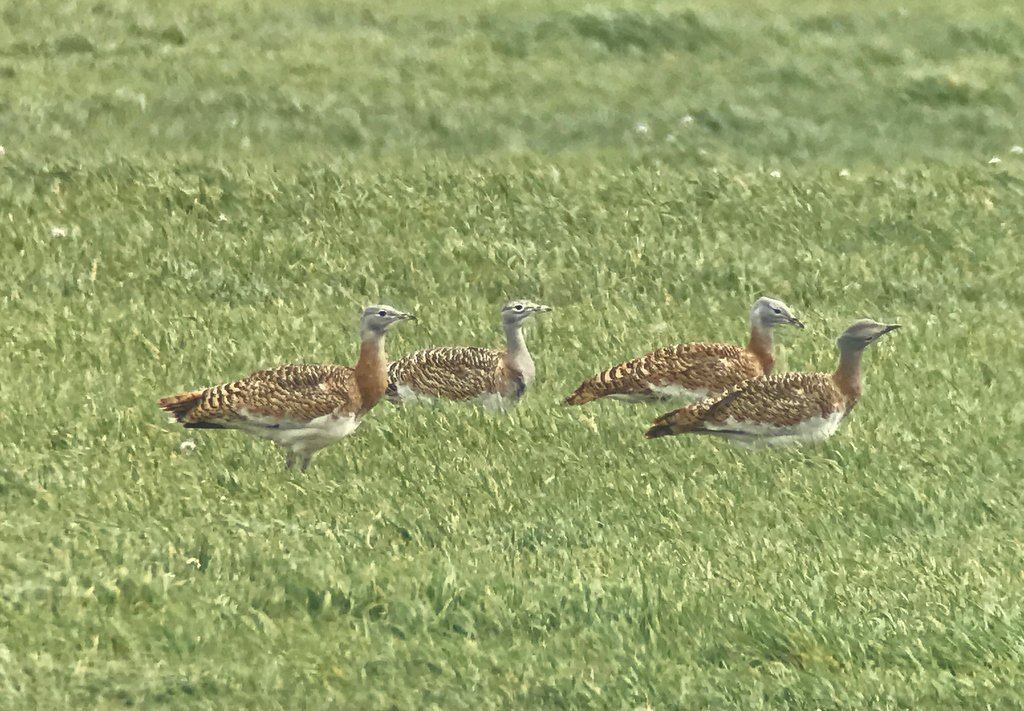
Exploring a little further along some farm tracks, we also found a few Black-bellied Sandgrouse, though they were all extremely nervous and flighty and our best views were from inside the vehicle. Another Hen Harrier, a ringtail this time, was quartering low over the steppe and the whole area was full of larks of various species.
With the bustards in the bag, we decided to head back towards our accommodation and check the steppe near Belchite on the way to see if we could find more sandgrouse. En route, we had simply fabulous views of a young Golden Eagle, hunting some low hills right beside the road.

Onto the agricultural steppe, and despite the strengthening winds, we first found some more flighty Black-bellied Sandgrouse and then an obliging pair of Stone Curlews crouching at a field edge. Our day was rounded off spectacularly though by at least sixty Pin-tailed Sandgrouse, which were more settled and allowed us to enjoy both scope views from afar, and some lovely close views from the van. It was wonderful to watch them wheeling around like bejewled Golden Plovers, and to hear their fantastic calls. It was the perfect end to a really productive day.
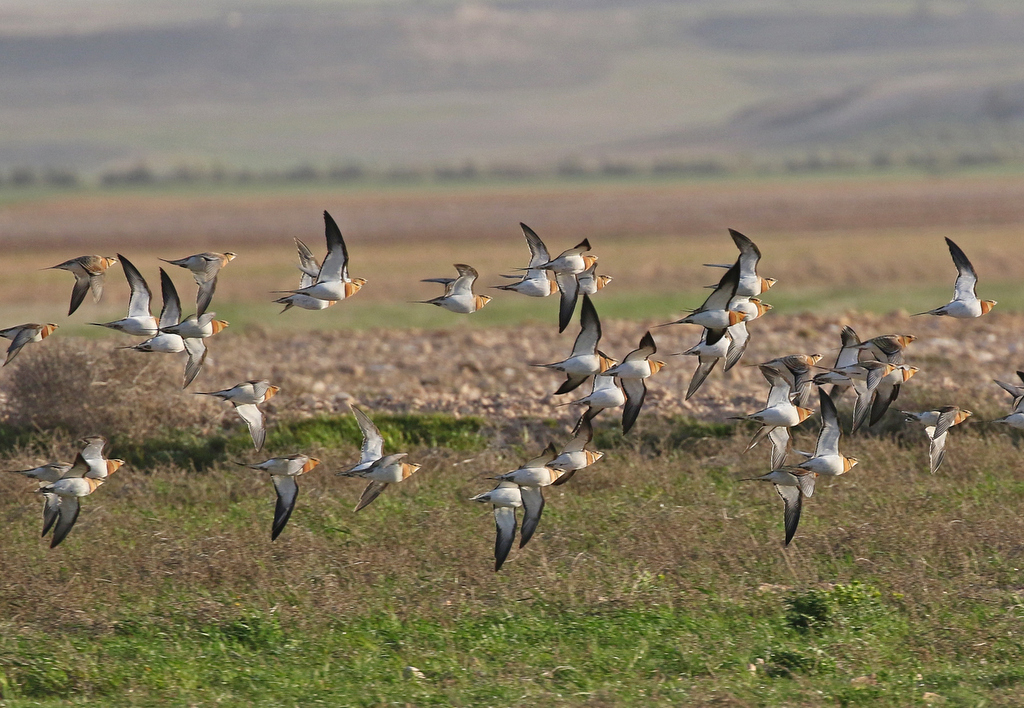
MONDAY 2ND MARCH
It was a very stormy night in Lecera as gale force winds and heavy rain swept through in the early hours, meaning it was very grim when we met up at 0730 for breakfast. By the time we were ready to load up and head off though, it had cleared quite a bit and despite the continuing strong winds and showers, it had brightened up.
We made the ninety minute drive east to Candasnos, and then on towards Fraga, where we made a stop for coffee and toilets and to check a spot where Lesser Kestrels breed and could already be arriving. We didn’t see any, but instead we were treated to fantastic views of 7 Egyptian Vultures grounded by the weather and sitting in a field right beside the track. Careful positioning of the van meant we could all get some great views and photos of these newly arrived migrants.
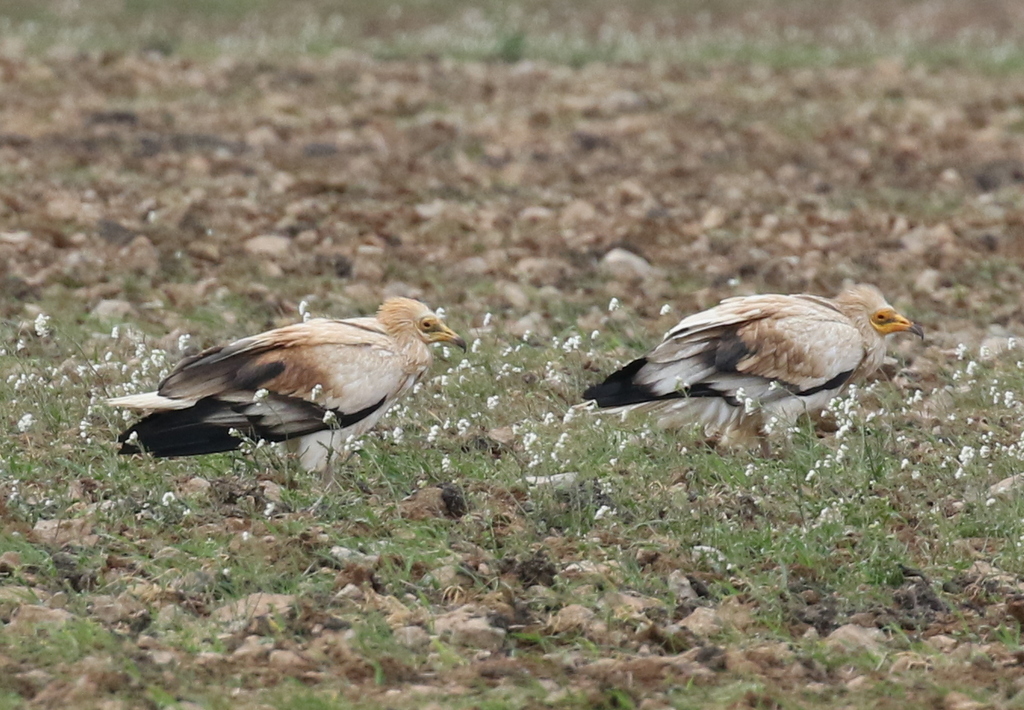
Kicking on east, our next stop was in Lleida steppes at a site for Eagle Owl. The wind was absolutely howling but we managed to find a little shelter and soon we were scoping an adult Eagle Owl roosting inside a bush up on the cliffs opposite. At first we could only see the birds streaked chest, but by taking a track a bit closer, we were eventually able to see its ear tufts and deep orange eyes as it squinted down at us from its lofty hiding place. A bonus was also seen in the form of a young Goshawk, which flew over us mobbed by a Raven.
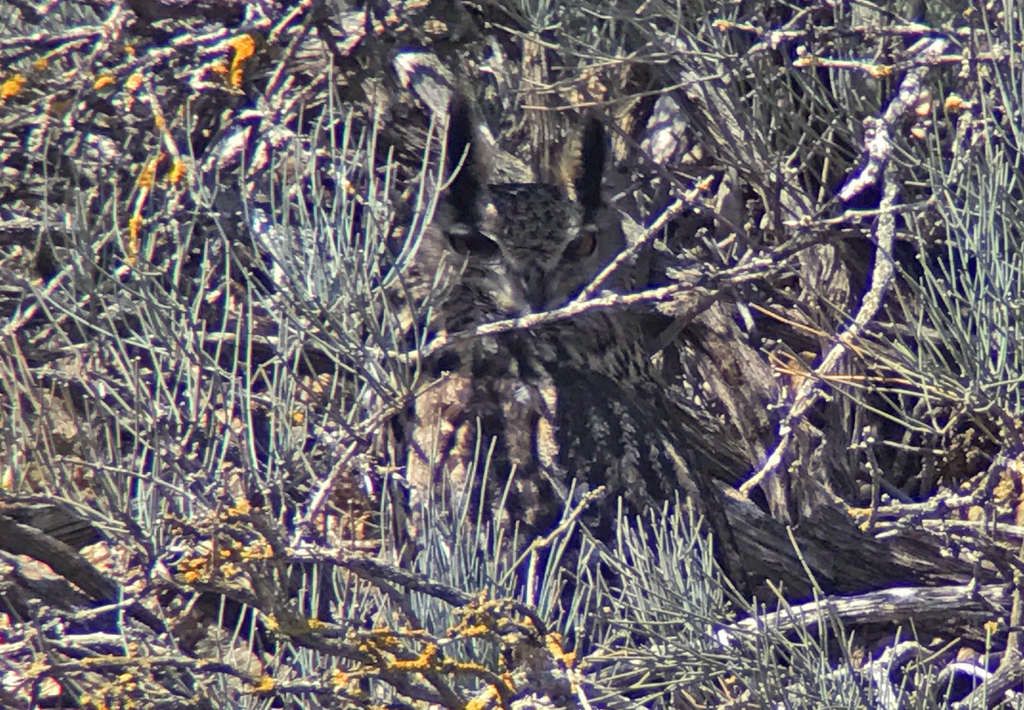
For lunch, we continued on into an area of agricultural steppe dotted with peach and olive groves and checked some fields there for another wintering flock of Little Bustards. 110 birds had been seen in recent days, but initially we couldn’t see any at all as we sheltered in van for lunch.
A quick check a bit further down the track though and all of a sudden a row of 70 heads popped up in a thickly vegetated field – Little Bustards! We managed to negotiate another track and get fairly close to them by using the van as a mobile hide. Nice to see a larger flock and get slightly closer views than previously.
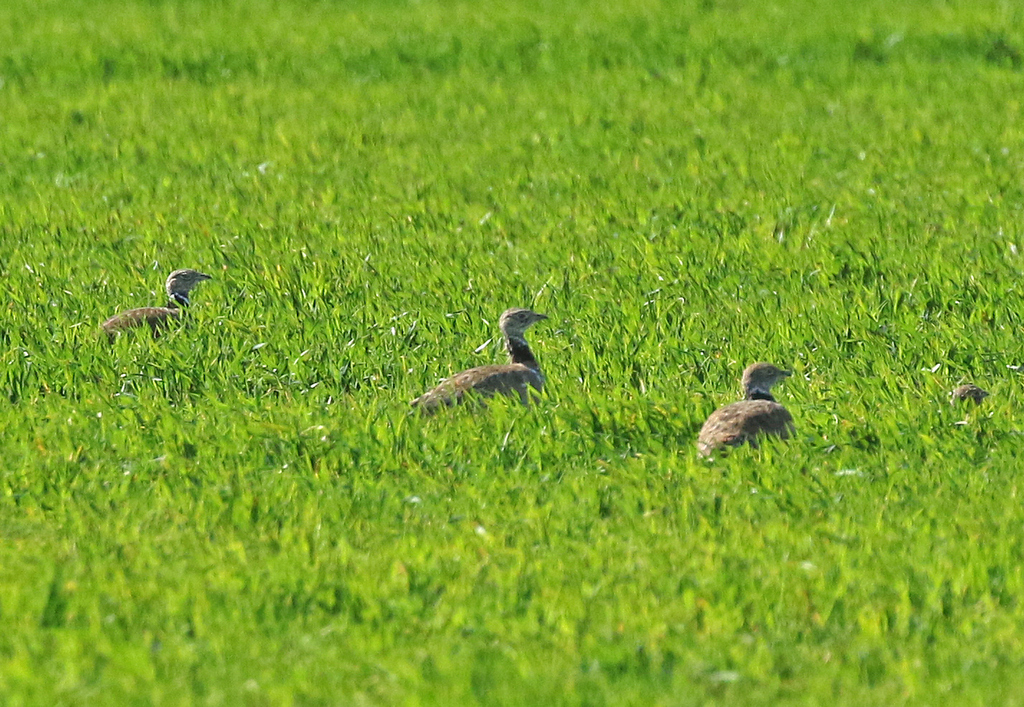
From here we had a further eighty minutes to run through to Barcelona, where after a quick stop to top up the fuel, we had about fifteen minutes left to check the beach near Llobregat. Due to the strong winds, the beach was deserted – this certainly did us a big favour as immediately on arrival we saw three gorgeous Audouin’s Gulls which flew in over us and landed on the shore. Several Mediterranean Gulls were also seen and our last trip bird was a Gannet battling through the waves into the strong winds.

We arrived at the airport around 4pm, only to discover our flight back to London was almost th
















